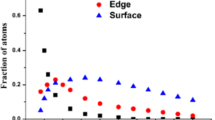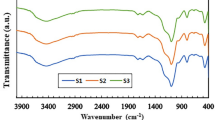Abstract
A sol-gel process for preparing SnO2 monolith of high specific surface area and transparency from chloride solution is described. Without introducing any alkaline precipitating reagent to induce condensation, this new process employs tin chloride (or its hydrate), water, and, optionally, alcohols as the only process reagents. Spontaneous solution-to-sol and sol-to-gel transitions take place upon mixing these reagents under appropriate conditions, and the entire transition processes are carried out under acidic conditions (typically pH ⩽ 4.0). The rate of condensation has been found to increase with decreasing SnCl4 concentration, which corresponds to decreasing solution acidity, and with increasing temperature. For fixed starting salt concentration and temperature, there exists an optimum amount of ethanol addition for the fastest condensation. Good performance of thus derived SnO2 monolith has been demonstrated in two applications, including catalytic oxidation and solid-state gas-sensing for carbon monoxide.
Similar content being viewed by others
References
M. J. Fuller and M. E. Warwick, J. Catal. 29, 441 (1973).
F. Sala and F. Trifiro, J. Catal. 34, 68 (1974).
P. G. Harrison and P. J. F. Harris, U.S. Patent 5,051,393 (1991).
T. Seiyama, A. Kato, K. Fujishi, and M. Nagatani, Anal. Chem. 34, 1502 (1962).
K. Takahata, in Chemical Sensor Technology, edited by T. Seiyama (Kodansha, Tokyo, and Elsevier, Amsterdam, 1988), Vol. 1, p. 39.
A. Camanzi and G. Sberveglierri, U.S. Patent 5,185,130 (1993).
T. J. Coutts, Active and Passive Thin Film Devices (Academic Press, London, 1978).
J. C. Manifacier, Thin Solid Films 90, 297 (1982).
B. E. Yoldas, J. Mater. Sci. 10, 1856 (1975).
C. J. Brinker and G. W. Scherer, Sol-Gel Science (Academic Press, San Diego, CA, 1990).
D. C. Bradley, E. V. Caldwell, and W. Wardlaw, J. Chem. Sci., 4775 (1957).
M. J. Hampden-Smith, T. Wark, and C. J. Brinker, Coordination Chemistry Reviews 112, 81 (1992).
S. S. Kistler, J. Phys. Chem. 36, 52 (1932).
E. W. Giesekke, H. S. Gutowsky, P. Kirrov, and H. A. Laitinen, Inorg. Chem. 6, 1294 (1967).
R. S. Hiratsuka, S. H. Pulcinelli, and C. V. Santilli, J. Non-Cryst. Solids 121, 76 (1990).
R. T. Presecatan, S. H. Pulcinelli, and C. V. Santilli, J. Non-Cryst. Solids 147 & 148, 340 (1992).
G. Heiland and D. Kohl, in Chemical Sensor Technology, edited by T. Seiyama (Kodansha, Tokyo, and Elsevier, Amsterdan, 1988), Vol. 1, p. 15.
A. Grisel and V. Demarne, in Chemical Sensor Technology, edited by T. Seiyama (Kodansha, Tokyo, and Elsevier, Amsterdam, 1988), Vol. 2, p. 43.
Author information
Authors and Affiliations
Rights and permissions
About this article
Cite this article
Wu, NL., Wu, LF., Yang, YC. et al. Spontaneous solution-sol-gel process for preparing tin oxide monolith. Journal of Materials Research 11, 813–820 (1996). https://doi.org/10.1557/JMR.1996.0098
Received:
Accepted:
Published:
Issue Date:
DOI: https://doi.org/10.1557/JMR.1996.0098




